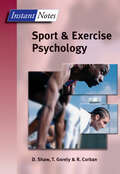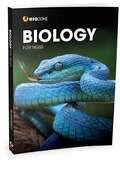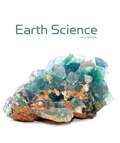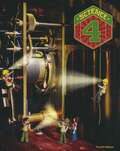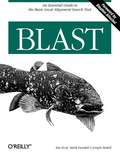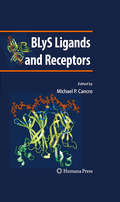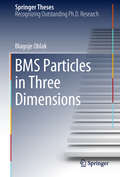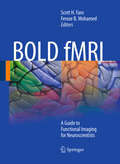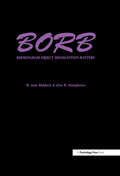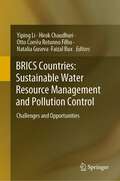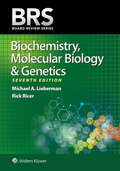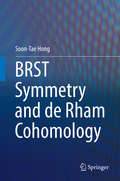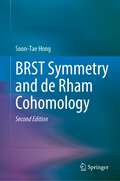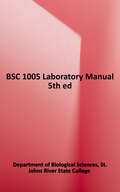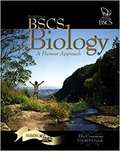- Table View
- List View
BIOS Instant Notes in Sport and Exercise Psychology (Instant Notes)
by Trish Gorely Dave Shaw Rod CorbanInstant Notes in Sport and Exercise Psychology provides concise coverage of sport and exercise psychology at the undergraduate level, and also covers the crucial basic psychology that underpins the subject. It has four main themes: theoretical approaches and research methods sport psychology at both the individual and group level of analysis exercise psychology practical applications including performance enhancement and ethics. Suitable for students in sport and exercise science, sport psychology, sport studies and sports management, it will be useful for coaches and athletes who wish to gain an up-to-date understanding of the key concepts, theories and research in this area.
BIOZONE Biology for NGSS
by Kent Pryor Lissa Bainbridge-Smith Sarah Gaze Jillian MellanbyBiology for NGSS has been specifically written to meet the requirements of the Next Generation Science Standards (NGSS) for high school Life Sciences (HS-LS). Users of this truly NGSS-aligned resource can be assured that the three dimensions (Disciplinary Core Ideas, Science and Engineering Practices, and Crosscutting Concepts) form the basis of each activity. Structured on the Disciplinary Core Ideas of the NGSS framework, this title provides a flexible approach to delivering NGSS. BIOZONE’S high-quality infographics and inquiry-driven pedagogical approach inspires students to be curious about the scientific world. Our unique, interactive worktext approach encourages direct interaction with the content, allowing students to record their answers within the context of the stimulus material and form a record of work for quick and easy revision.
BJU Earth Science (Fifth Edition)
by Rachel Santopietro David M. QuigleyEarth Science (5th Edition) Student Text moves the student from the lithosphere of the earth itself to the hydrosphere in and on the earth to the atmosphere surrounding the earth and finally out into space visiting the solar system and the rest of the universe. All of this is a quest to understand God's created world. Case studies and other activities encourage students to think like scientists as they develop a biblical perspective of earth and space.
BJU Press Science 4 Student Text
by Bju PressThis Science 4 Student Text (4th Edition, copyright update) from BJU Press presents science through bright photographs, updated text and interesting sidebars. Children will learn of creation through a biblical lens as chapters highlight interesting facts about insects & spiders, plants, electricity, light, force, the moon, erosion, digestion, bones, and muscles. Quick check sections review and reinforce concepts learned, while the last page of each chapter provides key terms and concepts. Experiments, activities and projects are also included for a hands-on, interactive year of science!
BJU Science 4 (Fourth Edition)
by Bju PressScience 4 Student Text, 4th ed., teaches concepts such as the characteristics of living things, insects and spiders, plants, forces and machines, electricity and magnetism, and the digestive and skeletal systems. Students are encouraged to think critically about science and to approach science from a biblical worldview. Each section ends with several Quick Check questions to assess student understanding. The Student Text also contains instructions for experiments, activities, and projects, a summary page of vocabulary and key concepts at the end of each chapter. Several units include worldview-shaping lesson from Answers in Genesis. - Publisher.
BLAST
by Joseph Bedell Ian Korf Mark YandellBLAST (Basic Local Alignment Search Tool) is a set of similarity search programs that explore all of the available sequence databases for protein or DNA. BLAST is the only book completely devoted to this popular and important technology and offers biologists, computational biology students, and bioinformatics professionals a clear understanding of this program. This book shows you how to get specific answers with BLAST and how to use the software to interpret results. If you have an interest in sequence ana
BLAST
by Joseph Bedell Ian Korf Mark YandellSequence similarity is a powerful tool for discovering biological function. Just as the ancient Greeks used comparative anatomy to understand the human body and linguists used the Rosetta stone to decipher Egyptian hieroglyphs, today we can use comparative sequence analysis to understand genomes. BLAST (Basic Local Alignment Search Tool), is a sophisticated software package for rapid searching of nucleotide and protein databases. It is one of the most important software packages used in sequence analysis and bioinformatics. Most users of BLAST, however, seldom move beyond the program's default parameters, and never take advantage of its full power. BLAST is the only book completely devoted to this popular suite of tools. It offers biologists, computational biology students, and bioinformatics professionals a clear understanding of BLAST as well as the science it supports. This book shows you how to move beyond the default parameters, get specific answers using BLAST, and how to interpret your results. The book also contains tutorial and reference sections covering NCBI-BLAST and WU-BLAST, background material to help you understand the statistics behind BLAST, Perl scripts to help you prepare your data and analyze your results, and a wealth of tips and tricks for configuring BLAST to meet your own research needs. Some of the topics covered include: BLAST basics and the NCBI web interface How to select appropriate search parameters BLAST programs: BLASTN, BLASTP, BLASTX, TBLASTN, TBLASTX, PHI-BLAST, and PSI BLAST Detailed BLAST references, including NCBI-BLAST and WU-BLAST Understanding biological sequences Sequence similarity, homology, scoring matrices, scores, and evolution Sequence Alignment Calculating BLAST statistics Industrial-strength BLAST, including developing applications with Perl and BLAST BLAST is the only comprehensive reference with detailed, accurate information on optimizing BLAST searches for high-throughput sequence analysis. This is a book that any biologist should own.
BLyS Ligands and Receptors (Contemporary Immunology)
by Michael P. CancroThis volume will center on the BLyS(BAFF) family of ligands and receptors. It will be divided into sections based on topics covering both basic and translational/clinical aspects of this molecular family's biology. It will focus heavily the BLyS family's role in the differentiation, selection, and regulation of primary and antigen-experienced B cells. Additional sections will cover clinical aspects of this family, including its association with autoimmunity and neoplasia, current thinking about the mechanistic basis for these associations, and the potential of BLyS family members as therapeutic targets. In addition, how BLyS family members play roles in other cell types may be included.
BMS Particles in Three Dimensions (Springer Theses)
by Blagoje OblakThis thesis presents the state of the art in the study of Bondi-Metzner-Sachs (BMS) symmetry and its applications in the simplified setting of three dimensions. It focuses on presenting all the background material in a pedagogical and self-contained manner to enable readers to fully appreciate the original results that have been obtained while learning a number of fundamental concepts in the field along the way. This makes it a highly rewarding read and a perfect starting point for anybody with a serious interest in the four-dimensional problem.
BOLD fMRI: A Guide to Functional Imaging for Neuroscientists
by Feroze B. Mohamed Scott H. FaroFunctional magnetic resonance imaging (fMRI) measures quick, tiny metabolic changes that take place in the brain, providing the most sensitive method currently available for identifying, investigating, and monitoring brain tumors, stroke, and chronic disorders of the nervous system like multiple sclerosis, and brain abnormalities related to dementia or seizures. This overview explains the principles of fMRI, scanning methodlogies, experimental design and data analysis, and outlines challenges and limitations of fMRI. It also provides a detailed neuroanatomic atlas, and describes clinical applications of fMRI in cognitive, sensory, and motor cases, translating research into clinical application.
BORB: Birmingham Object Recognition Battery
by Glyn W. Humphreys Jane M. RiddochBORB provides a set of standardised procedures for assessing neuropsychological disorders of visual object recognition, based on tests developed in the cognitive neuropsychological literature. The tests are introduced in terms of cognitive neuropsychological analyses of object recognition, and guidance is given concerning test use and interpretation. The tests assess low-level aspects of visual perception (using same-different matching of basic perceptual features, such as orientation, length, position and object size), intermediate visual processes (e.g., matching objects different in viewpoint), access to stored perceptual knowledge about objects (object decision), access to semantic knowledge (function and associative matches) and access to names from object (picture naming). BORB will serve as an invaluable companion test battery to the PALPA test of language ability.
BRICS Countries: Challenges and Opportunities
by Faizal Bux Yiping Li Hirok Chaudhuri Otto Corrêa Rotunno Filho Natalia GusevaThis book provides a detailed study and assessment of water resources management andpollution control in different BRICS countries. The regions involved areBrazil, Russia, India, China and South Africa. This book gives importantinsight into how future sustainability depends on the development of effectivewater governance mechanisms at the level of countries. According to theregional characteristics from different aspects it cuts into the waterenvironment problems and studies in different ways, which is multifaceted andtargeted. Using case studies that include environmentally integrated basinexperiments (eibex) of Brazil, groundwater overflow zone of India, semi-aridriver basin of South Africa and so on, this volume provides criticalinformation for researchers and policymakers.
BRS Biochemistry, Molecular Biology, and Genetics: Board Review Series (Board Review Series)
by Michael A. Lieberman Rick RicerPublisher's Note: Products purchased from 3rd Party sellers are not guaranteed by the Publisher for quality, authenticity, or access to any online entitlements included with the product. Practical, approachable, and perfect for today’s busy medical students and practitioners, BRS Biochemistry, Molecular Biology, and Genetics, Seventh Edition helps ensure excellence in class exams and on the USMLE Step 1. The popular Board Review Series outline format keeps content succinct and accessible for the most efficient review, accompanied by bolded key terms, detailed figures, quick-reference tables, and other aids that highlight important concepts and reinforce understanding. This revised edition is updated to reflect the latest perspectives in biochemistry, molecular biology, and genetics, with a clinical emphasis essential to success in practice. New Clinical Correlation boxes detail the real-world application of chapter concepts, and updated USMLE-style questions with answers test retention and enhance preparation for board exams and beyond.
BRST Symmetry and de Rham Cohomology
by Soon-Tae HongThis book provides an advanced introduction to extended theories of quantum field theory and algebraic topology, including Hamiltonian quantization associated with some geometrical constraints, symplectic embedding and Hamilton-Jacobi quantization and Becci-Rouet-Stora-Tyutin (BRST) symmetry, as well as de Rham cohomology. It offers a critical overview of the research in this area and unifies the existing literature, employing a consistent notation. Although the results presented apply in principle to all alternative quantization schemes, special emphasis is placed on the BRST quantization for constrained physical systems and its corresponding de Rham cohomology group structure. These were studied by theoretical physicists from the early 1960s and appeared in attempts to quantize rigorously some physical theories such as solitons and other models subject to geometrical constraints. In particular, phenomenological soliton theories such as Skyrmion and chiral bag models have seen a revival following experimental data from the SAMPLE and HAPPEX Collaborations and these are discussed. The book describes how these model predictions were shown to include rigorous treatments of geometrical constraints because these constraints affect the predictions themselves. The application of the BRST symmetry to the de Rham cohomology contributes to a deep understanding of Hilbert space of constrained physical theories. Aimed at graduate-level students in quantum field theory, the book will also serve as a useful reference for those working in the field. An extensive bibliography guides the reader towards the source literature on particular topics.
BRST Symmetry and de Rham Cohomology
by Soon-Tae HongThis book provides an advanced introduction to extended theories of quantum field theory and algebraic topology, including Hamiltonian quantization associated with some geometrical constraints, symplectic embedding and Hamilton-Jacobi quantization and Becchi-Rouet-Stora-Tyutin (BRST) symmetry, as well as de Rham cohomology. This extended new edition offers a multifaced insight into phenomenology of particles such as baryons and photons, in terms of extended objects. In particular, in the second edition, the baryons are described in hypersphere soliton model, and the photon properties are additionally included in stringy photon model and in Dirac type relativistic quantum mechanics for a photon.It offers a critical overview of the research in this area and unifies the existing literatures, employing a consistent notation. Although the results presented apply in principle to all alternative quantization schemes, special emphasis is placed on the BRST quantization and its de Rham cohomology group which contribute to a deep understanding of constrained physical theories. The book describes how solitons and other models subject to constraints include rigorous treatments of the geometrical constraints which affect the predictions themselves. The book is intended for use by any graduate-level student with quantum field and relativity theories, and it also serves as a useful reference for those working in the field. An extensive bibliography guides the reader toward the source literature on particular topics.
BSC 1005 Laboratory Manual
by Department of Biological Sciences St. Johns River State CollegeEssentials of Biology is an introductory biology text for non-major students that combines Dr. Sylvia Mader's superb and accessible writing style with clear visuals, a comprehensive learning system, and abundant applications and relevancy. Essentials of Biology explains the principles of biology clearly and illustrates them in a captivating, easy-to-understand manner. It emphasizes the relevance of biology to students' lives within a framework of biodiversity and is organized around the major concepts of biology--cells theory, gene theory, evolution, the theory of homeostasis, and ecosystems.
BSCS Biology: A Human Approach (2nd Edition)
by BscsThis book helps students learn biology through active involvement. With six key features of the program, viz., Unifying Themes, Subthemes, Instructional Model, Cooperative Learning, Assessment, and Educational Technology, students will enjoy learning biology in the new way of human approach.
BSCS Biology: A Human Approach (3rd Edition)
by BscsWhen faced with a problem or a puzzle, how do you figure things out? You might answer, "I think about them." But are you aware of how you think? This biology program focuses on science as one of the ways humans understand and explain their world. The activities throughout this program encourage you to think as a scientist does.
BSCS Biology: A Molecular Approach (Blue Version, Ninth Edition)
by The Editors at the BSCSThis book supports an inquiry approach to biology and challenges students to think scientifically, to integrate concepts, to analyse data, and to explore complex issues.
BSCS Biology: A Molecular Approach, Blue Version
by The editors of McGraw-hillNIMAC-sourced textbook
BSCS Biology: A Molecular Approach, Blue Version (7th edition)
by BscsThis book approaches seven principles largely from the perspective of molecular biology and focuses on minute structures such as cells and genes, as well as on the processes related to them. These principles are: * evolution: patterns and products of change * interaction and interdependence * genetic continuity and reproduction * growth, development, and differentiation * energy, matter, and organization * maintenance of a dynamic equilibrium * science, technology, and society
BSCS Biology: An Ecological Approach, Green Version (8th edition)
by BscsThis eighth edition of BSCS Biology: An Ecological Approach is the first edition of Green Version that will be used well into the twenty-first century, the beginning of a new millennium whose first decade will provide significant challenges to science education and to the quality of life on our ever-more-crowded planet.
BSCS Biology: An Ecological Approach, Green Version (9th edition)
by BscsExcept for the most desolate and forbidding regions of the polar ice caps, all of the earth teems with life. The study of life is called biology. Biology includes the study of the structure and function of individual organisms, the relationships among organisms, and the relationships among organisms and their environment.
BSCS Science: An Inquiry Approach
by Barbara Resch Fran SevinBSCS Science: An Inquiry Approach represents a new generation of textbooks for a new generation of high school science students, like you. As with all BSCS materials, An Inquiry Approach is an innovative science program that is centered on the Learner.
